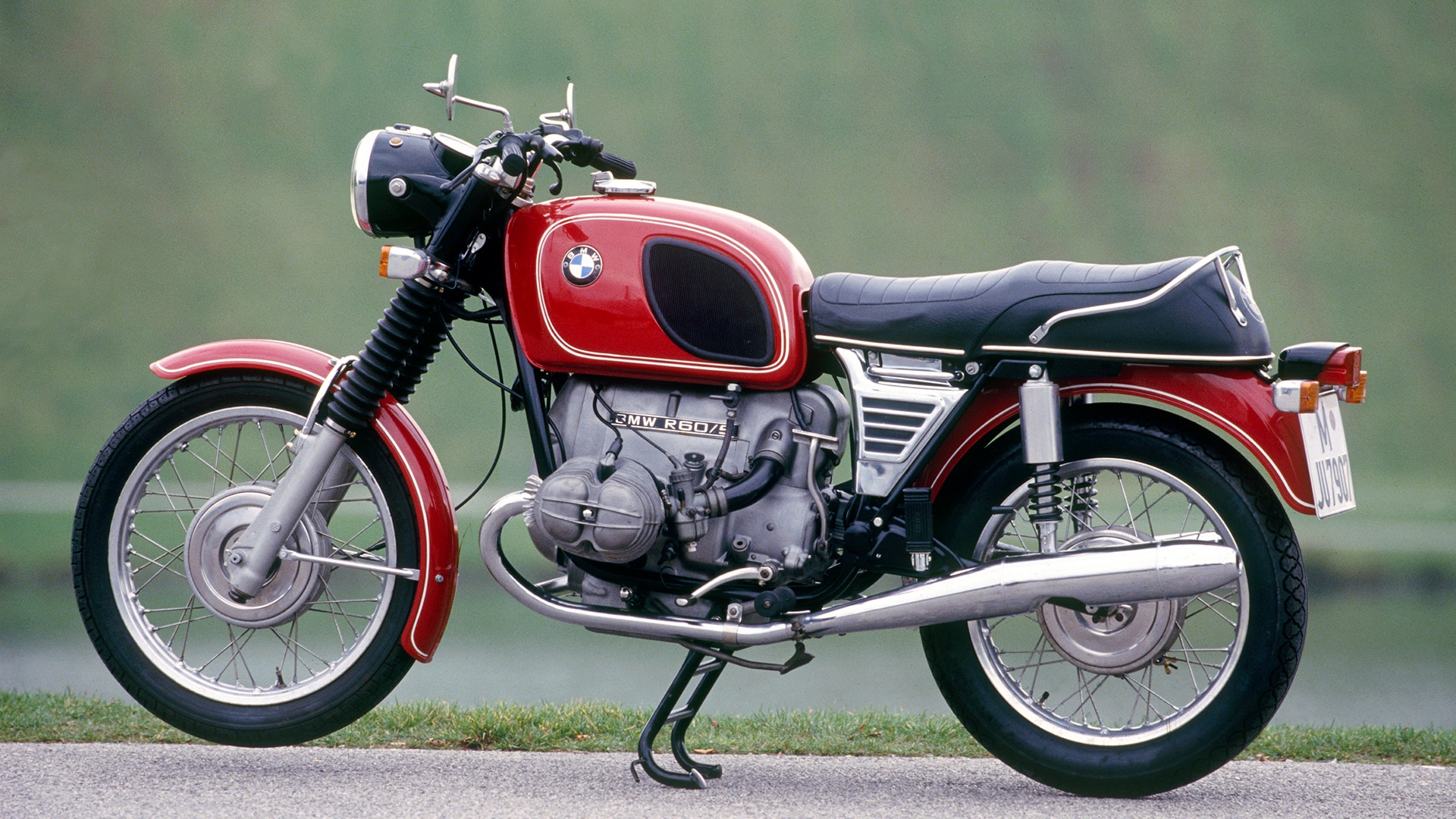Up turn.
The two-wheeler boom leads from Munich to Berlin.
In Berlin-Spandau, where aircraft engines were built up to 1945 and subsequently tool machine facilities were installed, the BMW motorcycles are given their new home and Berlin air in their tyres. In keeping with the new motorcycle boom, BMW manufactures a completely newly developed series with the /5 models.
Motorcycling becomes a hobby.
Motorcycling becomes a hobby.
The attitude towards motorcycles has changed: customers are more leisure-oriented and motorcycling is becoming increasingly popular as a hobby amongst wealthier circles, too. The /5 Series fulfils all the demands made of a modern motorcycle at the beginning of the seventies.
Read more
BMW motorcycles all over the world.
In the sixties, BMW put its faith in the well-established chassis of the full swing-arm models launched in 1955 which set new standards in ride stability both on their own and with sidecar. In 1969 two sports models, the R 50 S and the R 69 S, are brought in to supplement the model range. The latter is the fastest production German motorcycle with a maximum speed of 175 kph, allowing BMW to establish itself amongst the top international class. BMW motorcycles not only glide along European roads but also conquer the US highways. Many of the machines produced in the sixties are supplied to the USA, but in other continents, too, BMW motorcycles become an increasingly common sight on the roads.
+ Read more
The motorcycles of the 1960s
1960: R 69 S.
1960: R 69 S.
The sporty top-of-the-range model, the R 69 S, was unveiled to the public. With 42 hp and a top speed of 175 km/h, it attracted a great deal of attention in Germany and beyond. The crankshaft of the R 69 S engine was fitted with a mount damper. Good rideability is achieved through the use of a hydraulic steering damper.
Read more
1967: R 69 US.
1967: R 69 US.
Specially with the North American market in mind, BMW offered a version of its boxer models with telescopic front fork from 1967 onwards. This helped to bridge the waiting time for the newly developed /5 series in the USA as the most important foreign market.
Read more
1969: R 50/5.
1969: R 50/5.
The /5 series was a fundamental redesign of the boxer model: lightweight double cradle tubular frame with rear wheel rocker arm and telescopic front fork, crankshaft and con-rod, three-phase generator, battery ignition, electric starter, vacuum throttle carburettor. This was the first time that other colours like silver, blue and red were available in addition to black and white. The entry-level model R 50/5 is the last BMW with the classic 500 cc cylinder capacity.
Read more
1969: R 60/5.
1969: R 60/5.
The R 60/5 was a fundamental redesign of the boxer model: lightweight double cradle tubular frame with rear wheel rocker arm and telescopic front fork, crankshaft and con-rod, three-phase generator, battery ignition, electric starter, vacuum throttle carburetor. The electric starter was provided as standard. This was the first time that other colours such as silver, blue and red were available in addition to black and white.
Read more
1969: R 75/5.
1969: R 75/5.
The R 75/5, the top model of the /5 model series offered the same chassis as the other models of the /5 series but, thanks to the 750 cc cylinder capacity, had a stunning 50 hp output and a top speed of 175 km/h. This meant that BMW was well placed to meet the motorcycle boom of the 1960s.
Read more
More decades
- 1920s.
- 1930s.
- 1940s.
- 1950s.
- 1970s.
- 1980s.
- 1990s.
- 2000s.
1920s.
The foundations.
At the Berlin Motor Show in September 1923, the starting signal was given for the construction of BMW motorcycles: The R 32 is the first BMW motorcycle, developed by Max Friz. The world-renowned boxer engine will be the manufacturers main characteristic.
1930s.
Of records and races.
In the 1930s, the engineers not only considered performance development, but also introduced, for example, the hydraulically damped telescopic fork and the elaborately designed OHV boxer engine - with unique consequences and successes.
1940s.
On with pioneering spirit.
After the turmoil of the war, BMW manages a new start with motorcycle production. First they build the R 24 a single-cylinder motorcycle limited to 250 cc.
1950s.
Back on top.
The 1950s are marked by sporting successes. BMW achieves remarkable top speeds with a series-manufactured machine. Furthermore the drivers of motorcycle teams win world championship titles.
1970s.
Protection against wind and weather.
A new era is being introduced: Cockpit and full fairings make driving on the motorcycle more comfortable. There are sporty motorbikes. In particular, the R 90 S is a popular design classic - not least because of its elaborate two-tone paintwork.
1980s.
New technology, new segment.
The motorcycle manufacturer surprises with pioneering innovations and the new segment of travel enduro. After the revolutionary single-arm swing from 1980, the BMW Paralever system is introduced in 1987 in the R 100 GS.
1990s.
Pioneer, trendsetter.
The new four-valve boxer with electronic engine management and the first BMW single-cylinder motorcycle since 1966 come on the market in the 1990s. In addition, in the spring of 1991, BMW Motorrad became the world's first motorcycle manufacturer to offer a regulated three-way catalytic converter for motorcycles.
2000s.
Sportier and more dynamic than ever.
Several new models and technical innovations are driving the growth at BMW Motorrad: the new K-Series now comes with a transversely mounted engine, and the newly developed F-Series fuels the mid-range segment. At the end of the decade, BMW Motorrad will introduce one of the most important new releases on the market - the S 1000 RR marks the first time that the brand has entered the world of superbikes.





